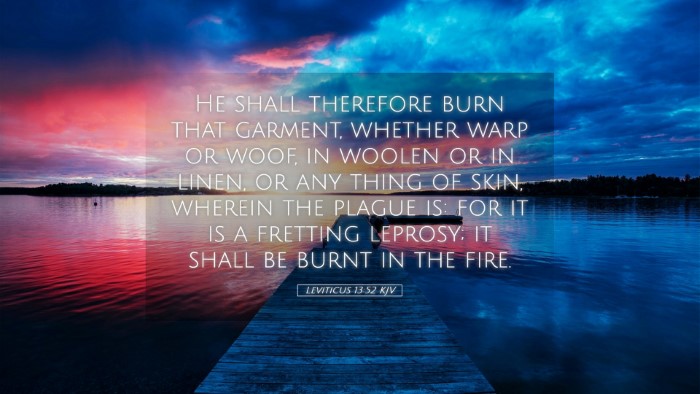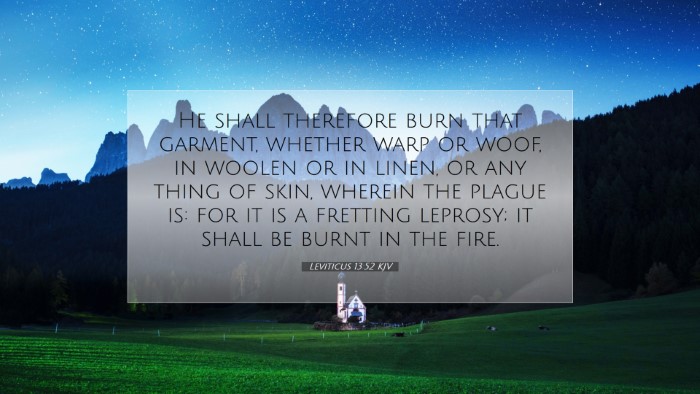Commentary on Leviticus 13:52
Text: "And he shall burn that which the plague hath eaten up with fire; it is a dry scale, whether the managing or the fold thin in the skin, and it can be eaten up with a rest of fire." (Leviticus 13:52)
Introduction
The laws prescribed in Leviticus, particularly those relating to leprosy and other skin diseases, serve a dual purpose: they maintain the physical health of the Israelite community and reflect a rich theological significance. Leviticus 13:52 addresses the disposition of garments contaminated by leprosy, marking an important aspect of ceremonial cleanliness and impurity.
Understanding the Context
Matthew Henry's commentary emphasizes the severe implications of leprosy, which serves as a metaphor for sin—contagious and destructive. This verse deals specifically with the cleansing rituals regarding apparel, pointing to the broader concept of purity within the community of Israel. The act of burning symbolizes complete removal and the seriousness with which the Israelites must regard impurity.
Albert Barnes elaborates, stating that cleanliness goes beyond mere physical health. He notes that God’s instructions reflect His holiness and the necessity for His people to reflect this holiness in both their lives and their possessions.
The Symbolism of Fire
Adam Clarke provides insight into the use of fire as a purging agent. In biblical literature, fire often symbolizes judgment and purification. Burning the contaminated garments signifies total eradication of the source of impurity and indicates a new beginning—much like fire refining precious metals by removing the dross.
Moreover, Clarke points out that the act of burning is both protective and restorative, preventing the spread of the disease within the community and allowing for the potential for new, undefiled garments to replace those lost to impurity.
Health, Community, and Holiness
The underlying theme in this passage relates to the hygiene and societal health of the Israelite community. Matthew Henry argues that God’s law seeks not only to keep individuals safe from physical ailments but also promotes the overall wellbeing of society by preventing contamination.
In a broader theological context, the burning of leprous garments foreshadows the purification Christ offers through His sacrifice, emphasizing that true cleansing cannot be achieved through human means alone but requires divine intervention.
Practical Applications for Today
For pastors and theologians, Leviticus 13:52 holds several practical applications:
- Holiness in Community: The necessity for communal holiness and the measures taken to protect the community from sin and impurity remain relevant today. Leaders must emphasize the importance of purity in the body of Christ.
- Dealing with Sin: Just as leprosy required immediate attention and action, sin must be addressed without delay. The church is called to apply biblical discipline to restore those who falter.
- The Role of Judgment: While God is loving and merciful, He is also the righteous judge. The burning of contaminated items serves as a reminder of the serious consequences of sin and God's call to holiness.
- Reflecting on Personal Cleanliness: Individuals are encouraged to examine their own lives for spiritual 'leprosy'—those areas that might cause spiritual or relational harm, and to take appropriate actions toward cleansing.
Conclusion
Leviticus 13:52 may seem focused on a specific ceremonial law, yet its implications extend into the realms of spiritual health, community ethics, and theological reflection. By understanding the significance of this verse, believers can deepen their appreciation for the theme of purification throughout scripture and its ultimate fulfillment in Christ.


